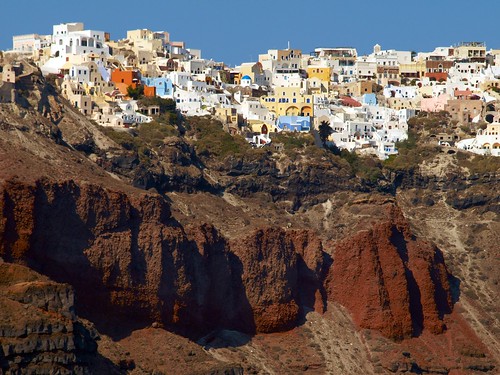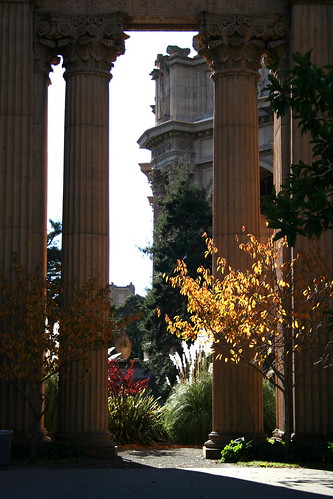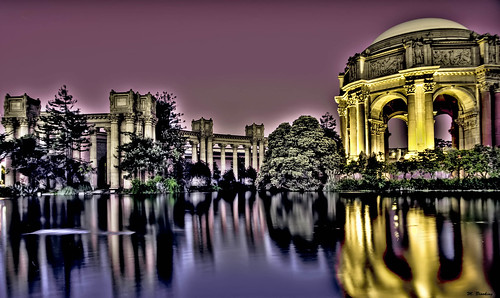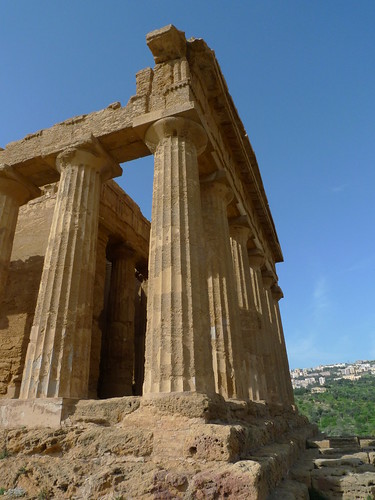Wednesday, 30 November 2011
Petra, JORDAN
Tuesday, 29 November 2011
My Big Fat Greek Wedding (1)
Sunday, 27 November 2011
Neo Classicism Enlightenment - Treatment of Classic Themes in Modern Style

Neoclassicism is a unique movement in the decorative, literature, classical arts and theatre that originated in the middle of the 18th century. Ancient Greek and Roman culture draw upon the Western classical arts and culture during this era.
Neo classicism artists do not make dreary reproductions of their creations- be it arts, sculpture or poetry but makes something new and innovative every time. This ensures a high standard. However a neo classical artist runs more chance in churning out mediocre and innocuous stuff in his over enthusiasm to be different. More than just creating something entirely new, neoclassicism is a natural expression of a culture with all its elements and the finesse with which an artist regains the lost elements that might have slipped into the oblivion is what makes a neo classic artist successful and popular.
Neoclassicism has thrown open countless possibilities in interior designing, inspired by the rediscoveries at Pompeii and Herculaneum, dating back to the 1740s. Intelligent and sensuous application of these styles has resulted in the creation of some of the most enchanting interiors in the Baroque style. The Roman styled rooms of William Kent were actually based on the classic basilica and temple exterior architecture, which was given a different treatment.
Pastel colored motifs, sculpted in low relief or monotone paintings, suspended ribbons and vases were all used lavishly in neo classic creations. In the 1800s a theme of etchings and engravings in Greek architectural examples, set off a trend called the Greek revival.
Neoclassicism started in England and France and was quickly accepted by the artists of Rome and Sweden. A second, more prominent neoclassic wave came into being during Napoleonic Empire, which stood out for spectacular engravings. In France, the first spell of neoclassicism is often called the "Louis XVI style", where as the second phase is referred to as "Directoire" or Empire. Italy stuck to the Rococo style until the Napoleonic regimes infused new archaeological classicism, which became a strong political for the young urbanites with republican leanings in Italy.
At the end of the world wars, a neo classic movement in the Arts came into being. This movement which shunned romanticism was noted for its religious (especially Christianity) themes, the foundation of which was laid by T. E. Hulme in English literature. Some of the most popular neo classicists in English included T. S. Eliot and Wyndham Lewis among others.
Neo Classicism enlightenment set off an interesting trend, which gave a new treatment to the classic themes. You can find all the information of this interesting trend in art and literature using the free search engine of Jrank.
Saturday, 26 November 2011
"The home of the Gods" Markandstacy's photos around Athens, Greece (going from metoera to bari)
Friday, 25 November 2011
AGIA TRIA�DA Crete, Greece
Tuesday, 22 November 2011
Historic Falling Spring c.1830
Sunday, 20 November 2011
Foreign Influences on Buddhism

Foreign influences stimulated mythology and imagery in India. In the reliefs of Ashoka's time, the image of the Buddha never appears, and, as in the earliest Christian art, the intention of the sculptors is to illustrate an edifying narrative rather than to provide an object of worship. But in the Gandharan sculptures, which are a branch of Græco-Roman art, he is habitually represented by a figure modelled on the conventional type of Apollo. The gods of India were not derived from Greece but they were stereotyped under the influence of western art to this extent that familiarity with such figures as Apollo and Pallas encouraged the Hindus to represent their gods and heroes in human or quasi-human shapes.
The influence of Greece on Indian religion was not profound: it did not affect the architecture or ritual of temples and still less thought or doctrine. But when Indian religion and especially Buddhism passed into the hands of men accustomed to Greek statuary, the inclination to venerate definite personalities having definite shapes was strengthened.
Persian influence was stronger than Greek. To it are probably due the many radiant deities who shed their beneficent glory over the Mahayanist pantheon, as well as the doctrine that Bodhisattvas are emanations of Buddhas. The discoveries of Stein, Pelliot and others have shown that this influence extended across Central Asia to China and one of the most important turns in the fortunes of Buddhism was its association with a Central Asian tribe analogous to the Turks and called Kushans or Yüeh-chih, whose territories lay without as well as within the frontiers of modern India and who borrowed much of their culture from Persia and some from the Greeks.
To learn more about Buddhist teachings and beliefs, you might be interested in my FREE E-EBOOK "Buddhism for the Non-Buddhist Layman"
You will also find many free articles about Buddhist teachings, beliefs and practices in my site: Buddhism Through Buddhist Eyes
Saturday, 19 November 2011
Plaka, Anafiotika & Syntagma (Αθήνα/Athens)
Friday, 18 November 2011
Agenda: With George Friedman
Wednesday, 16 November 2011
6 Most Exquisite Places to Visit in Europe

With so many interesting places to visit in Europe deciding what the best six exquisite places to visit during your vacation is indeed a difficult decision.
The first city on my list would have to be Paris. Not only known for its famous sights such as the Arc de Triomphe, The Louvre, Notre Dame Cathedral and of course the Eiffel Tower, the city is also the heart of fashion and chic. A trip down the Champs Elysees with its exclusive expensive stores will soon confirm that fact.
Barcelona is located near the Spanish border with France and is a city unlike any other in Europe. Dating back to Roman times the city was transformed by the Olympics in 1992 and boasts some extraordinary modern architecture, and yet, the city has still managed to retain its ties with its proud historic past.
Rome the 'Eternal City' is one of the most visited destinations in the world. Once the capital of western civilization, the city displays it's amazing and famous ancient heritage in a proud and spectacular manner. Places to see include The Colosseum, The Forum, Arch of Constantine, The Pantheon and the Ancient Temples of Rome. A visit to the Vatican and St Peter's Basilica is definitely a highlight of any trip to Rome.
Once the home of many famous Greek philosophers such as Plato and Socrates, Athens is definitely a place that should be on your list of European attractions. The major historic sites are mostly located around the Acropolis and offer a truly exciting, impressive and memorable experience for any tourist.
If the hot humid summers in Athens become too much, then you must take a trip to one or more of the beautiful Greek Islands such as Crete, Mykonos, Rhodes or Corfu to name a few. Most of these Islands are known for their fantastic beaches and friendly inhabitants. Corfu is regarded as one of the most beautiful places in Greece with its lush vegetation and incredible night life.
Exploring Venice with its scenic canals and bridges, spectacular buildings and famous landmarks makes this a unique magical experience for any traveler. Filled with romance, history, good food and photo opportunities at every corner, Venice is undoubtedly an experience that you will never forget. Don't miss taking a trip on a Gondola down the Grand Canal with its impressive palaces lining the route or visiting St Mark's Square, The Basilica and The Doge's Palace.
London is one of the great cities of the world. It offers tourist's access to unique sites that were for centuries at the core of western civilization. The city is packed with notable churches, historic cathedrals, a variety of museums, stunning Palaces, art galleries, gourmet restaurants and world class shopping at stores such as Harrods and Selfridges. Must see places include the Tower of London, Buckingham Palace, Westminster Abbey, Big Ben, St. Paul's Cathedral, Covent Garden, The Temple, the City of London, London Eye, Tate Modern, the Globe Theater, Imperial War Museum, Piccadilly Circus, Trafalgar Square, National Gallery, Oxford Street Kensington Palace, Harrods, the Science Museum, the Natural History Museum, The British Museum, the British Library, London's Street Markets, Madame Tussaud's, Tower Bridge and a host of other places to numerous to mention.
The list is endless. It all depends on your personal choice and preference. But one thing is sure, whatever your choice may be, you will love the exquisite and picturesque locations of Europe.
Visit Villa World to get detailed descriptions of 1000's of different types of rental properties, bed and breakfast accommodations or rental properties for self catering holidays that can be tailored to fit your pocket. More importantly you can negotiate directly with the home owner, thus cutting out the middle man which makes for a very cost effective way of budgeting.
Monday, 14 November 2011
Attractions in Greece - Where to Go and What to See in Greece

Depending on whereabouts you go there are plenty of attractions in Greece to keep everyone more than occupied and even better a lot of them do not cost anything for you to go and enjoy.
If you are looking for a wonderful mix of modern-day meeting old world traditions, ancient history and mythology then Parga on the Greek mainland has some of the most superb attractions in Greece that you can hope to find.
You do not have to go far to experience the legacy left by previous invaders with the ruins of a 14th Century Venetian castle overlooking the harbor entrance high up on the hill which is very well worth the climb and not just for the fantastic views and scenery.
Also, a bit further around the coastline is Ali Pashas castle and you can either walk or (and I can thoroughly recommend this way of getting there) make use of the Parga train (think tractor decked out to resemble a train and you have the idea) and this is a far less strenuous way of doing it.
The Parga train takes you up to the castle and once there you have the benefit of the guide to tell you everything about Ali Pasha himself and the history of the castle and it is a very informative and worthwhile trip.
On the way back (still on the train) you get to stop off at a lovely village to make use of the local hospitality with some great tavernas and coffee shops before making your way back to Parga itself. The whole trip takes about 2 hours and represents great value for money with some stunning views and scenery too.
A little further afield you get to see anything from more amazing ruins to national parks and areas of outstanding natural beauty to the simply unique and breathtaking Meteora which are a combination of man-made and naturally occurring phenomena that have to be seen to be believed.
The name Meteora cannot prepare you for the sight of huge granite rocks with their stunning Monasteries that were built on top of them around the 14th century and of the 24 that were originally built there are 6 still inhabited today.
If you fancy a bit of island hopping to really see what other parts of Greece are all about then Paxos and Antipaxos are a short boat ride away or just a little further over the water is Corfu and all the delights that it has to offer.
So, apart from sun, sea, sand and fantastic food there are plenty of attractions in Greece and Parga in particular to keep everyone entertained really easily.
You can discover full details and information relating to Parga as well as Greece by visiting this Parga Holiday Review website. Full of interesting facts and special offers with great images of this beautiful part of the Greek mainland, visit=> http://www.squidoo.com/parga-holiday-review
Saturday, 12 November 2011
Griekse cultuur
Friday, 11 November 2011
The Architecture Of New Orleans

New Orleans is one of the few American cities that has managed to retain much of its historic architecture. The French Quarter has many buildings dating back 150 years or more, while the Garden District has splendid mansions designed in a variety of styles. Beautiful houses line Esplanade Avenue, historically the residential nucleus of the Creole elite, and the city also possesses a good stock of 19th-century public buildings built in Greek Revival style. It is not always easy to categorize buildings by style, for many of them are hybrids, like the Gallier House, which incorporated both Creole and American features.
Creole Cottage
Only a few buildings, such as the Old Ursuline Convent and Lafitte's Blacksmith Shop (see p78), remain from this period, which combines various French styles of the 18th century. Most were destroyed by a series of fires: one, in 1788, destroyed 856 wooden buildings; a second in 1794 destroyed 212 buildings.
Spanish Colonial
After the 1788 and 1794 fires, the Spanish decreed that any building of more than one story must be constructed of brick. The houses that were subsequently built can still be seen in the French Quarter.
They often combine residence and store, and feature arcaded walls, heavy doors and windows, and a flagstone alleyway leading to a loggia and fountain-graced courtyard
Federal Townhouse
Americans from the Atlantic states brought their own architectural preferences with them, and the successful among them erected Federalstyle homes that stand out from the French or Spanish cottages surrounding them in the Quarter.
Raised American Cottage
Most of these raised cottages feature extensive eaves and an alleyway leading to a rear garden or courtyard. The interior usually contains four rooms arranged symmetrically and separated by a center hall. The kitchen and servants' quarters are away from the house at the rear.
Shotgun House
These cottages were so called because a bullet fired from a shotgun through the front door would go straight through the house and out the back as all the doors were aligned. They come in single and double versions, and usually have a set of box steps in front.
The Creole Plantation House
The refugees from Saint Dominguez (Haiti) brought this Caribbean-style dwelling to New Orleans. This one-story residence is usually raised on brick pillars (to catch the breezes and to cope with flooding) and incorporates a wraparound veranda. The space below the house and the flagstone piazza below the veranda are used as service or storage areas.
For More info, Please Visit travel directories and travel directory
Wednesday, 9 November 2011
Classical Orders of Greek Architecture
Monday, 7 November 2011
Grèce découverte des monuments de l'Acropole d'Athénes ( Greece Acropolis of Athens )
Saturday, 5 November 2011
Friday, 4 November 2011
Wednesday, 2 November 2011
Getty Villa Museum - Pacific Palisades, California
Tuesday, 1 November 2011
Cycles of Memphis Architecture

What does Memphis, Tennessee share with major cities like Chicago? The answer would be: an exceptional number of historic buildings. The city can boast of over eleven thousand national register listings. While historic examples can be seen everywhere, Memphis doesn't feature just one style. As the city has experienced ups and downs financially and the effects of both World Wars and the Great Depression, the design of both commercial and residential buildings has been altered. An attempt to apply modern principles can also be seen throughout the wider urban area.
A series of yellow fever epidemics ravaged Memphis during the late 1800's cutting the population in half. Everything slowed down, including building projects as the city worked hard just to survive. Homes prior to the epidemics can still be viewed, especially in the midtown area. Clano Hall (1853), the Hunt-Phalen House (1830), and Annesdale (1855) are a few examples of everything from antebellum Federal brick architecture to Italian Villa style..
By the 1890s, functionality had become more important in architectural design. Superfluous architectural flourishes died off as an emphasis on regularity and volume came into vogue. The influence of modernism spread from residential to commercial and even industrial properties. Steel buildings replaced older structures along the venerable Memphis streets of Union Ave,Main st., and Madison. Memphians also would alter the facade of older building to be more in keeping with modern styles. Memphis counted it's first skyscraper by 1914. The emergence of the streetcar also allowed the first development of Memphis's future historic home in subdivisions such as Central Gardens and Annesdale Park.
These new suburban residential areas became middle class modernist communities. Higher end properties can also been seen with expensive materials and spacious yards. The cottages and smaller homes were either Craftsman style or a modern version of Greek Revival design. Occasionally, an imitation of Frank Lloyd Wright's Prairie School style was also interspersed, boasting bands of wooden casement windows, horizontal lines, and deep overhanging roofs.Very utilitarian housing projects were also included, but it wasn't until 1924 that the city started designating certain areas to be residential, commercial, or industrial.
Atypically for Memphis, Memphis led the nation in focusing on the design of smaller affordable homes. The Memphis small builder's association published a catalogue with more than a hundred design plans costing less than six grand. Also, local architects offered their services at a reduced rate. Such was the community concern for helping residents secure their own homes after the Great Depression.
In some ways, WW II dampened enthusiasm for modern European architectural styles. International styles lost popularity with the association with the feuding Europeans. A small historical oddity was the late 1950 attempt by Mies van der Rohe to reestablish modern design with steel framed houses and glass curtains. Remains of this can be seen in Memphis even today.
Today, Memphis has had a prolonged buyer's market, and hopeful home owners can choose from fine homes in the downtown and riverfront areas. Memphis has rejuvenated itself starting with a downtown renaissance and working its way west. Older commercial buildings are being renovated while the Midtown area has salvaged its southern charm. In the far east, faux-estates with acreage abound. While there are homes for sale in every price range, values are appreciating, and the higher the price the more the competition. With pro-sports teams, museums, year-round festivals, cultural activities, and southern ambiance, Memphis Tennessee offers a great place to settle in and raise a family.
There's the history of Memphis architecture for you.
To learn more about the related subject of realtors of Memphis, tn possibilities and to search homes of Memphis visit the distributing site.